SECTION 10-G 1955 BUICK LIGHTS – LIGHTING SYSTEM
10-47 1955 BUICK LIGHTING SWITCH AND CIRCUIT BREAKER
Description of 1955 Buick Lighting Switch
The 1955 Buick lighting switch is a “push-pull” type which also incorporates a manually operated rheostat for controlling the map and 1955 Buick instrument panel lights. Three “push-pull” positions of the switch knob provide control of the exterior lights as follows:
- “Off” position (knob all the way in) cuts off all 1955 Buick lights controlled by the switch.
- “Parking” position (knob pulled out to first notch) turns on the parking lights, tail lights, and license light and key light. The map and instrument panel lights also will be turned on if the rheostat is set for these lights.
- “Driving” position (knob pulled out to last notch) turns parking lights off and turns headlights on, while the other lights remain as in the “Parking” position. The headlights will be on the “upper” or “lower” beams depending on the position of the separate dimmer switch.
In the “Parking” and “Driving” positions the 1955 Buick lighting switch knob must be rotated to control the map and instrument panel lights. With knob turned all the way counterclockwise these lights are off. Turning the knob clockwise the first step turns on the map lights only, the second step turns on the instrument lights and leaves map lights on, the third step turns map lights off and leaves the 1955 Buick instrument lights on; further turning of knob clockwise reduces the brilliance of instrument panel lights.
Description of 1955 Buick Thermo Circuit Breaker
A 1955 Buick thermo circuit breaker is incorporated in the 1955 Buick lighting switch assembly, to protect wiring from damage due to short circuits in any lighting circuit controlled by the switch.
The thermo circuit breaker consists of a bimetal blade and set of contact points connected in series with the 1955 Buick lighting circuits. An abnormal flow of current through the circuit breaker, such as would be caused by a short circuit in a lighting circuit, heats the bi-metal blade sufficiently to separate the points and cause them to vibrate. The vibrating blade alternately opens and closes the circuit, thus reducing the flow of current and protecting the wiring against overheating and burning. The flickering light produced by the vibrating circuit breaker serves as a warning to the operator of vehicle that a short circuit exists.
Test of 1955 Buick Lighting Switch
If the 1955 Buick lighting switch is suspected of being faulty, the contacts can be tested by connecting a short jumper wire between No.1 terminal and the other terminals while observing any change in the brilliance of 1955 Buick lights affected.
With switch in “Parking” position (first notch out) connect jumper wire between No. 1 and No. 2 terminals and note change in parking lights. Bridge between No.1 and No.3 terminals and note change in 1955 Buick tail lights. With switch in “Driving” position (last notch out) bridge between No. 1 and No. 4 terminals and note change in 1955 Buick headlights.
If no change in brilliance of lights is noted the switch contacts are satisfactory and the cause is in the wiring circuit connections or lamp bulb. If switch is faulty it must be replaced since internal repairs cannot be made.
Replacement of 1955 Buick Lighting Switch
- Disconnect battery cable from junction block and disconnect wires from 1955 Buick lighting switch.
- Pull switch knob out to last notch, then depress the spring loaded latch button on switch while pulling the knob and rod assembly out of switch.
- Remove switch mounting nut with Wrench J 1589 and remove switch and escutcheon from instrument panel. See figure 10-59.
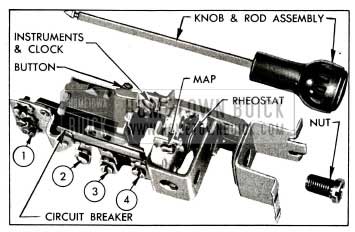
1955 Buick Lighting Switch
- When installing 1955 Buick lighting switch, connect wires according to color codes as shown on chassis wiring circuit diagrams in Section 10-J. When connecting battery ground cable use care to properly wind the clock (par. 10-56).
Test of 1955 Buick Thermo Circuit Breaker
To test the thermo circuit breaker, remove 1955 Buick lighting switch from instrument panel to avoid possible damage to adjacent instruments.
Since the current required to open the circuit breaker contacts depends somewhat on outside temperature, the circuit breaker should be tested at normal temperature (70° to 80°F.).
- Connect an ammeter and a carbon-pile rheostat in series with the No. 1 terminal of lighting switch and positive terminal of a 12- volt battery, and set rheostat to provide maximum resistance. Rheostat must have capacity for 30 amperes and be adjustable down to .3 ohms.
- With switch on, connect the No.3 terminal of 1955 Buick lighting switch to negative post of battery.
- Adjust rheostat to give 30 amperes. The circuit breaker should start vibrating in four minutes or less.
- Adjust rheostat to give 22 amperes on ammeter. The circuit breaker should remain closed indefinitely at 22 amperes.
- If circuit breaker does not operate as specified the lighting switch assembly should be replaced. The circuit breaker is not adjustable and no attempt should be made to alter the calibration by bending the bi-metal blade. The contact points must not be filed or sanded.
10-48 1955 BUICK HEADLIGHTS AND CONTROLS
1955 Buick Headlamp Assembly
The 1955 Buick headlamp assembly on each front fender consists of a body, wiring, connector, mounting ring, sealed beam unit, retainer ring, door and gasket. See figure 10-61.
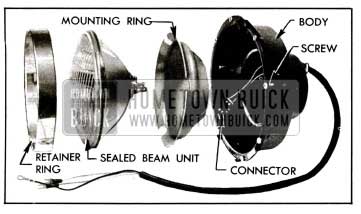
1955 Buick Headlamp Disassembled
The 1955 Buick headlamp body is attached to the fender with a gasket between body and fender to provide a water-tight seal. The wiring to which the connector is attached extends through rear of lamp body and connects to a terminal block on the radiator baffle. The mounting ring, which supports the sealed beam unit, forms a ball and socket joint with the body, to which it is attached by one coil spring and two beam adjusting screws. The sealed beam unit is plugged to the wiring connector and is held in the mounting ring by a retainer ring. The 1955 Buick headlamp door, which covers the retainer ring, is attached by two captive screws on Series 40-60 and by one screw and two barrel nuts on Series 50-70.
1955 Buick Sealed Beam Unit and Headlight Beams
The 1955 Buick sealed beam unit consists of a lens, reflector, terminal plug, and two lamp filaments assembled into one securely sealed unit. The lamp filaments are located with respect to the reflector so that two separate and distinct headlight beams may be obtained, depending upon which filament is burning.
When the lower lamp filament is burning, an upper or straight forward light beam is obtained. The upper beam is designed to illuminate the road evenly, and is for use on the highway when no other vehicles are approaching. See figure 10-60, view A.
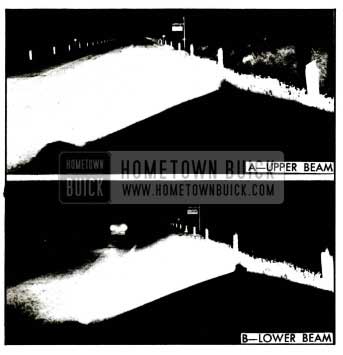
1955 Buick Light Distribution With Headlight Beams
When the upper lamp filament is burning, a lower or depressed light beam is obtained. The lower beam is designed so that it does not throw a dazzling light into the eyes of an approaching driver. At the same time, the distribution of light is such that the right side of road is illuminated as far ahead as is practicable without causing glare on curves. See figure 10-60, view B. The lower beam is intended for use in traffic and on the highway when meeting other vehicles
1955 Buick Dimmer Switch
The driver may select the upper or lower headlight beam as traffic and road conditions demand by operating the dimmer switch mounted on the toe panel in a convenient position for the left foot.
The 1955 Buick dimmer switch opens and closes the circuits to the upper and lower lamp filaments in both sealed beam units, thereby alternately raising and lowering the headlight beams with each successive operation of the switch. Depression of switch button turns the rotary contacts one position within the switch. The spring-loaded button automatically returns to the reset position when released. The switch contacts overlap so that the new circuit is closed before the previous one is opened, in order to prevent both beams being off at the same time during operation of the switch.
1955 Buick Headlight Beam Indicator
Whenever the upper headlight beams are lighted, a beam indicator bulb on the instrument panel also lights, producing a small spot of red light in front of the driver. For safety reasons, he should never pass an approaching car with the beam indicator showing red.
10-49 1955 BUICK HEADLAMP SEALED BEAM UNIT REPLACEMENT AND ADJUSTMENT
Replacement of 1955 Buick Sealed Beam Unit
When a 1955 Buick sealed beam unit is burned out or broken it must be replaced as a unit assembly. Two types of sealed beam units are available. In one type, the glass lens and a glass reflector are fused together. In the other type, the glass lens and a metal reflector are assembled together with a gasket to provide a tight seal. Both types are interchangeable.
- Remove 1955 Buick headlamp door.
- On first type, remove the three retainer ring screws but do not disturb the two beam adjusting screws, then remove retainer ring and remove sealed beam unit from mounting ring.
On second type, unhook the spring from retainer ring (fig. 10-62), then remove sealed beam unit and retainer ring, being careful not to disturb the two beam adjusting screws.
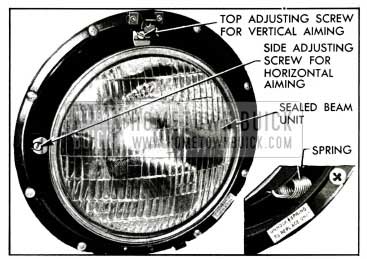
1955 Buick Sealed Beam Unit Mounting
- Separate the 1955 Buick sealed beam unit from the wiring connector.
- On second type, spring the retainer ring slightly where marked “TOP” to remove mounting ring and sealed beam unit. See figure 10-61.
- Install new sealed beam unit by reversing removal procedure. The lens is marked “TOP” and the reflector has three lugs which fit into notches in the headlamp mounting ring. CAUTION: Make sure that sealed beam unit installed has “12V” molded in center of lens to indicate 12-volt unit.
- Before installation of headlamp door, adjust headlamp for proper aim as described below.
1955 Buick Headlamp Aiming Adjustment
The 1955 Buick headlamps must be properly aimed in order to obtain the maximum road illumination and safety that has been built into the head lighting equipment. The 1955 Buick headlamps must be checked for proper aim whenever a sealed beam unit is replaced and after any adjustment or repairs of the front end sheet metal assembly.
Headlamp aiming machines are in general use. When using one of these machines make certain that it is in proper condition, and carefully follow the instructions of the manufacturer. 1955 Buick headlamp aiming charts are also available and will give good results if used properly; see subparagraph c below.
Regardless of method used for checking headlamp aim, car must be at curb weight, that is, with gas, oil, water, and spare tire, but no passengers. Tires must be uniformly inflated to specified pressure (par. 1-1). If car will regularly carry an unusual load in rear compartment, or a trailer, these loads should be on car when headlamps are checked. Some states have special requirements for headlamp aiming adjustment and these requirements should be known and observed.
Horizontal and vertical aiming of the 1955 Buick headlamp beam is provided by the two beam adjusting screws which move the mounting ring in the body against the tension of the coil spring. There is no adjustment for focus since the sealed beam unit is set for proper focus during manufacturing assembly. If 1955 Buick headlamps require adjustment for proper aim, proceed as follows:
- Remove 1955 Buick headlamp door.
- Adjust light beam up or down as required by turning the top beam adjusting screw. See
- Adjust light beam to right or left as required by turning the side beam adjusting screw.
- Check final setting of headlamps after installing headlamp doors.
Use of 1955 Buick Headlamp Aiming Chart
If a 1955 Buick headlamp aiming machine is not available a chart may be prepared as shown in figure 10-63.
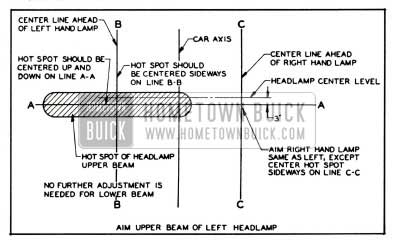
1955 Buick Headlamp Aiming Chart
It is desirable to make the chart on a large panel of plywood or other suitable material, painted flat white, so that it can be shifted into proper alignment with car, as explained later. Note that the chart consists of two horizontal and three vertical lines. The upper horizontal line is located at the same distance from floor as the center of headlamps and the lower horizontal line (A-A) is 3″ below the headlamp center line. Where State laws require a loading allowance be governed by these requirements for the lower line. Vertical lines B-B and C-C are located at the center of head lamps and equally distant from the center vertical line which corresponds to axis of car.
When using the 1955 Buick headlamp aiming chart, place car on a level stretch with chart placed 25 feet ahead of both headlamp lenses, and parallel to them. Place a narrow piece of masking tape on the exact vertical centerline of the back window glass. Shift chart sideways as required to bring the center vertical line into exact alignment with the center of radiator ornament and center of the back window glass.
Set lighting switch in “driving” position and operate dimmer switch to give upper beam. Cover right headlamp and note light pattern made on chart by the left headlamp. The center of zone of highest light intensity should fall on the intersection of horizontal line A-A and the vertical line B-B as shown in figure 10-63. Cover left headlamp and check right headlamp in the same manner.
10-50 1955 BUICK PARKING, TAIL, STOP, LICENSE AND BACK-UP LIGHTS
1955 Buick Front Parking and Signal Lights
Each 1955 Buick front parking and signal lamp contains one 32-4 CP lamp bulb which provides a 4 CP parking light and a separate 32 CP direction signal light. The pins on lamp bulb and slots in socket are offset to prevent improper installation of bulb in socket. The parking light is controlled by the lighting switch and the circuit is protected by the switch thermo circuit breaker. The 1955 Buick direction signal light is separately controlled by the signal switch and the circuit is protected by the “Direction Signal” fuse on the fuse block under the cowl.
1955 Buick Tail and Stop Lights
The combination tail, stop, and direction signal lamp on each rear fender contains one 32-4 CP lamp bulb which provides a 4 CP tail light and separate stop and direction signal lights which use the same 32 CP filament. The tail lights are controlled by the lighting switch and the circuit is protected by the switch thermo circuit breaker.
The 1955 Buick stop lights are controlled by a hydraulic switch mounted on the brake pipe distributor fitting near the master cylinder. The switch is closed by hydraulic pressure when the brakes are applied. The 1955 Buick stop light circuit is protected by the 9 ampere “Direction Signal” fuse mounted on the fuse block under the cowl.
A lamp bulb may be replaced by removing the lens and retainer assembly from rear lamp housing. Pins on the 32-4 CP bulb and slots in socket are offset to prevent improper installation of bulb in socket.
Replacement of 1955 Buick Stop Light Switch
When replacing 1955 Buick stop light switch have new switch ready to install as soon as old switch is removed from distributor fitting. Before installing new switch make sure that port in distributor fitting is filled with brake fluid. Have a helper gently depress brake pedal to fill the fitting from master cylinder, if necessary, then immediately install new switch.
If brake pedal has springy, spongy action after installation of stop light switch, air has entered brake pipes and it will be necessary to bleed the hydraulic system.
1955 Buick Rear License Light
A 1955 Buick rear license lamp is mounted in the inner side of each rear bumper guard to provide side lighting of license plate. Each lamp contains one 3 CP lamp bulb which operates in conjunction with the tail lights, and the circuit is protected by the lighting switch circuit breaker. The lamp socket is mounted in rubber to protect the lamp filament from shock and a bronze grounding washer completes the circuit when the sleeve nuts are tightened.
To replace a lamp bulb, raise rear compartment lid and remove two coin slotted sleeve nuts which attach the lamp socket and wire assembly to the forward side of lamp housing in bumper guard.
1955 Buick Back-Up Lamps and Switch
The 1955 Buick back-up lamps are mounted in the rear lamp housings on fenders of all models.
On Synchromesh cars, the 1955 Buick back-up light switch is mounted at the lower end of steering column jacket and is operated by the transmission control shift lever when placed in reverse position. With gear shift lever in neutral position, a clearance of 1/16″ should exist between the control shaft lower lever and the bent-over end of the switch arm. Slotted screw holes permit movement of the switch on its mounting bracket to obtain this clearance.
On Dynaflow cars, the 1955 Buick back-up light switch is combined with the neutral safety switch, which is mounted on the steering column jacket under the cowl. The switch is correctly set for back-up light operation when it is properly set for safety switch operation as described in paragraph 10-31.
10-51 1955 BUICK INTERIOR LIGHTS AND CIGAR LIGHTER
NOTE: See paragraph 10-5 for lamp bulb and fuse specifications.
1955 Buick Instrument Panel Lights and Switches
The speedometer, gauges and clock are illuminated by lamp bulbs mounted on forward side of instrument panel to provide indirect lighting. The 1955 Buick instrument panel lights are controlled by the lighting switch as described in paragraph 10-47 and the circuits are protected by the switch thermo circuit breaker.
1955 Buick Map Light and Switch
The 1955 Buick map light is located where the instrument panel is rolled over above the radio, in position to project light downward. The light is controlled by the lighting switch as described in paragraph 10-47.
To replace map light bulb, remove the two screws retaining the lens to instrument panel, then pull lens and mounting bracket downward to make bulb accessible.
1955 Buick Instrument Panel Compartment Light
The 1955 Buick instrument panel compartment (glove box) is lighted by a lamp bulb mounted in a light switch attached to top edge of the compartment. The spring-loaded switch makes contact when the compartment door is opened. As the door is closed it depresses the switch button to break contact and turn the light off. This circuit is protected by a 2 ampere fuse in the wiring connector under cowl to left of glove box.
1955 Buick Parking Brake Release Warning Signal
The 1955 Buick parking brake release warning signal, when installed, will show a red warning signal light on the instrument panel whenever the ignition switch is turned on while the parking brake is applied. The signal lamp is controlled by a switch mounted in position to be operated by the parking brake lever. The circuit is protected by a 9 ampere (Back-up Lite) fuse on the fuse block under cowl.
When brake lever is in fully released position, the signal switch plunger must be depressed 3/16″. Adjustment is made by loosening the mounting screws and shifting the switch as permitted by the slotted screw holes.
1955 Buick Direction Signal Indicator Lights
On Series 40-60 the direction signal indicator lamp bulbs are installed in a socket plate which snaps into an opening in instrument panel. The socket plate may be removed for replacement of bulbs by prying under the lower edge with a screwdriver.
On Series 50-70, each direction signal indicator lamp bulb is mounted in a socket supported by a plate which snaps into an opening under the rolled over section of the instrument panel. Figure 10-64 shows the method of removing and installing the socket for replacement of lamp bulb.
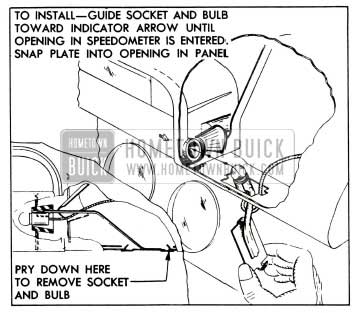
1955 Buick Signal Indicator Bulb Replacement-Series 50-70
1955 Buick Speed Ratio Dial Light
The 1955 Buick speed ratio dial on all Dynaflow cars is illuminated by a lamp bulb mounted in the steering column jacket, forward of the instrument panel. The light is controlled by the lighting switch in the same manner as all instrument panel lights. To replace the lamp bulb, remove the snap-in socket from the socket support plate.
1955 Buick Cigar Lighter
The Casco cigar lighter is heated by pressing the knob in until it latches; the knob will automatically unlatch and return to “off” position when heated to proper temperature. A replaceable thermal fuse located in the lighter base protects the lighter element against overheating if knob is manually held in for too long a period.

Leave A Comment
You must be logged in to post a comment.